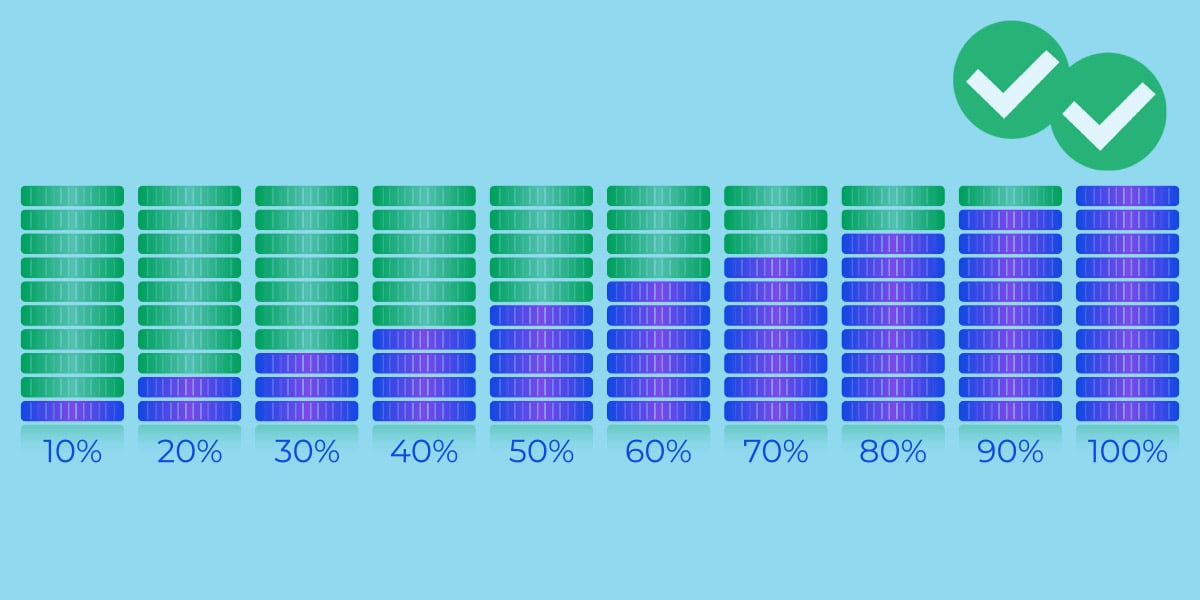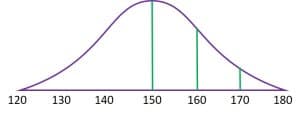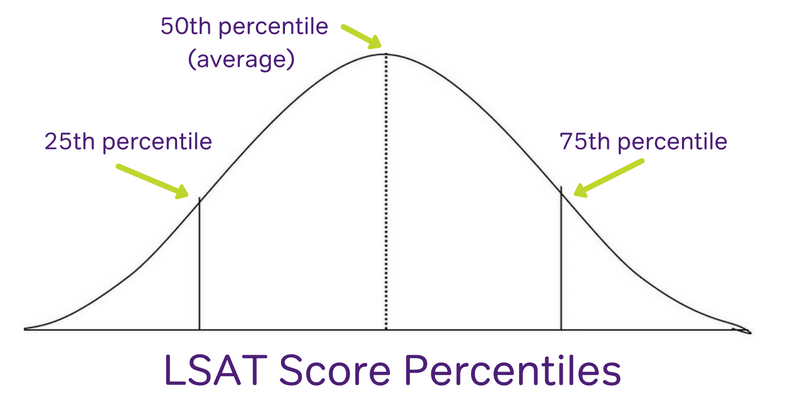
To find your LSAT percentile, you’ll convert your raw score to a scaled score, which has a corresponding percentile rank. If that feels like a lot, let’s face it: when it comes to the LSAT, there are a ton of numbers to process. Nope, not in the test itself—in LSAT scoring. So how do you perform an LSAT percentile conversion? You have to know key scoring terms, first of all: each possible LSAT score falls into a percentile rank, which shows the percentage of LSAT takers who performed below that score. This means that when you see your final LSAT score on your score report, two numbers appear:
- The first is your scaled LSAT score, which is the number out of 180 that we’re all familiar with.
- The second is your LSAT score percentile, which shows how you performed compared to other students who have taken the test before you.
Both scaled scores and LSAT percentile ranks change from one test to another. However, we’ve studied historical data from actual LSATs to help you calculate your LSAT percentage. Take a look!
Table of Contents
- The Current LSAT Score Percentile Conversion Chart
- The New August 2024 LSAT Score Percentile Conversion Chart
- How to Calculate Your LSAT Percentile
- What LSAT Score Percentiles Do You Need for Law School?
- LSAT Percentile Takeaways
The Current LSAT Score Percentile Conversion Chart
This conversion chart is based on the current LSAT that will be offered until August 2024. It has 3 scored sections (1 Logic Games section, 1 Reading Comprehension section, and 1 Logical Reasoning section) and 1 unscored section.
Note that this chart assumes a 75- or 76-question LSAT, while the actual range could be anywhere from 73 to 78 questions. However, the most recent tests have tended to have either 75 or 76 questions.
Using your raw score for this LSAT score percentile conversion will give lead you to both a scaled score and a percentile based on the most recent scores. Jump over the next section to learn more about finding your raw score and what it means!
| Current LSAT Raw Score | Current LSAT Scaled Score | Current LSAT Percentile |
|---|---|---|
| 75-76 | 180 | 99.9 |
| 74 | 177-180 | 99.8-99.9 |
| 73 | 177-180 | 99.8-99.9 |
| 72 | 175-179 | 99.6-99.9 |
| 71 | 173-178 | 99.0-99.9 |
| 70 | 172-176 | 98.6-99.7 |
| 69 | 170-175 | 97.4-99.6 |
| 68 | 169-174 | 96.6-99.3 |
| 67 | 168-173 | 95.5-99.0 |
| 66 | 167-172 | 94.3-98.6 |
| 65 | 166-170 | 92.9-97.4 |
| 64 | 166-169 | 92.9-96.6 |
| 63 | 165-169 | 91.4-96.6 |
| 62 | 165-168 | 91.4-95.5 |
| 61 | 163-167 | 97.1-94.3 |
| 60 | 162-166 | 84.9-92.9 |
| 59 | 162-165 | 84.9-91.4 |
| 58 | 161-164 | 92.4-89.4 |
| 57 | 160-163 | 79.4-87.1 |
| 56 | 159-162 | 76.5-84.9 |
| 55 | 159-161 | 76.5-82.4 |
| 54 | 158-161 | 73.6-82.4 |
| 53 | 157-160 | 70.0-79.4 |
| 52 | 157-159 | 70.0-76.5 |
| 51 | 156-158 | 66.4-73.6 |
| 50 | 155-157 | 62.8-70.0 |
| 49 | 154-157 | 59.0-70.0 |
| 48 | 154-156 | 59.0-66.4 |
| 47 | 153-155 | 55.1-62.8 |
| 46 | 152-155 | 51.1-62.8 |
| 45 | 152-154 | 51.1-59.0 |
| 44 | 151-153 | 47.6-55.1 |
| 43 | 150-153 | 43.9-55.1 |
| 42 | 150-152 | 43.9-51.1 |
| 41 | 149-151 | 40.1-47.6 |
| 40 | 148-150 | 36.3-43.9 |
| 39 | 147-150 | 32.6-43.9 |
| 38 | 146-149 | 29.7-40.1 |
| 37 | 146-148 | 29.7-36.3 |
| 36 | 145-147 | 26.0-32.6 |
| 35 | 144-146 | 23.0-29.7 |
| 34 | 143-146 | 20.5-29.7 |
| 33 | 142-145 | 17.7-26.0 |
| 32 | 141-144 | 15.5-23.0 |
| 31 | 141-143 | 15.5-20.5 |
| 30 | 140-142 | 13.3-17.7 |
| 29 | 139-141 | 11.3-15.5 |
| 28 | 138-140 | 9.6-13.3 |
| 27 | 137-139 | 8.1-11.3 |
| 26 | 136-138 | 6.8-9.6 |
| 25 | 135-138 | 5.5-9.6 |
| 24 | 134-137 | 4.7-8.1 |
| 23 | 133-136 | 3.9-6.8 |
| 22 | 132-135 | 3.2-5.5 |
| 21 | 131-134 | 2.6-4.7 |
| 20 | 129-133 | 1.7-3.9 |
| 19 | 127-132 | 1.1-3.2 |
| 18 | 125-131 | 0.7-2.6 |
| 17 | 123-130 | 0.5-2.0 |
| 16 | 121-129 | 0.3-1.7 |
| 15 | 120-127 | 0.0-1.1 |
| 14 | 120-125 | 0.0-0.7 |
| 13 | 120-123 | 0.0-0.5 |
| 12 | 120-122 | 0.0-0.4 |
| 11 | 120-121 | 0.0-0.3 |
| 0-10 | 120 | 0.0 |
The New August 2024 LSAT Score Percentile Conversion Chart
This conversion chart is for the new LSAT that begins in August 2024. It also has 3 scored sections, but the Logic Games section has been replaced with another Logical Reasoning section. The test-makers have stated that this change should have no effect on overall scores, so we’re using the same historical percentile data that they’ve provided.
Why is a separate chart needed then? Well, the first reason is that the new PrepTests have new raw-to-scaled-score conversion charts. And the second is that the upcoming table assumes a 77- or 78-question LSAT, which is the total number of questions that most of the new PrepTests have. Note that the actual range could be anywhere from 76 to 79 questions.
Using your raw score for this LSAT score percentile conversion will give lead you to both a scaled score and a percentile based on the most recent scores. Read on for more on finding your raw score and what it means!
| New LSAT Raw Score | New LSAT Scaled Score | New LSAT Percentile |
|---|---|---|
| 78 | 180 | 99.9 |
| 77 | 180 | 99.9 |
| 76 | 178-180 | 99.7-99.9 |
| 75 | 176-180 | 99.3-99.9 |
| 74 | 174-179 | 98.6-99.8 |
| 73 | 173-178 | 98.1-99.7 |
| 72 | 172-176 | 97.4-99.3 |
| 71 | 170-175 | 95.6-99.0 |
| 70 | 169-173 | 94.4-98.1 |
| 69 | 168-172 | 93.0-97.4 |
| 68 | 167-171 | 91.4-96.6 |
| 67 | 166-170 | 89.5-95.6 |
| 66 | 165-169 | 87.5-94.4 |
| 65 | 164-168 | 85.2-93.0 |
| 64 | 163-167 | 82.8-91.4 |
| 63 | 162-166 | 80.2-89.5 |
| 62 | 161-165 | 77.3-87.5 |
| 61 | 161-164 | 77.3-85.2 |
| 60 | 160-163 | 74.3-82.8 |
| 59 | 159-162 | 71.1-80.2 |
| 58 | 158-161 | 67.8-77.3 |
| 57 | 158-161 | 67.8-77.3 |
| 56 | 157-160 | 64.3-74.3 |
| 55 | 156-159 | 60.7-71.1 |
| 54 | 155-158 | 57.1-67.8 |
| 53 | 155-158 | 57.1-67.8 |
| 52 | 154-157 | 53.5-64.3 |
| 51 | 153-156 | 49.6-60.7 |
| 50 | 152-156 | 45.9-60.7 |
| 49 | 152-155 | 45.9-57.1 |
| 48 | 151-154 | 42.3-53.5 |
| 47 | 150-154 | 38.7-53.5 |
| 46 | 149-153 | 35.2-49.6 |
| 45 | 148-152 | 31.9-45.9 |
| 44 | 148-152 | 31.9-45.9 |
| 43 | 147-151 | 28.5-42.3 |
| 42 | 146-150 | 25.5-38.7 |
| 41 | 145-149 | 22.7-35.2 |
| 40 | 144-149 | 20.1-35.2 |
| 39 | 144-148 | 20.1-31.9 |
| 38 | 143-147 | 17.5-28.5 |
| 37 | 142-147 | 15.4-28.5 |
| 36 | 141-146 | 13.3-25.5 |
| 35 | 141-145 | 13.3-22.7 |
| 34 | 140-144 | 11.5-20.1 |
| 33 | 139-143 | 9.9-17.5 |
| 32 | 138-143 | 8.4-17.5 |
| 31 | 137-142 | 7.2-15.4 |
| 30 | 137-141 | 7.2-13.3 |
| 29 | 136-140 | 6.1-11.5 |
| 28 | 135-139 | 5.2-9.9 |
| 27 | 134-138 | 4.3-8.4 |
| 26 | 134-138 | 4.3-8.4 |
| 25 | 133-137 | 3.7-7.2 |
| 24 | 132-136 | 3.1-6.1 |
| 23 | 131-135 | 2.7-5.2 |
| 22 | 130-134 | 2.3-4.3 |
| 21 | 130-133 | 2.3-3.7 |
| 20 | 129-132 | 1.9-3.1 |
| 19 | 127-131 | 1.4-2.7 |
| 18 | 125-130 | 1.0-2.3 |
| 17 | 122-129 | 0.7-1.9 |
| 16 | 121-128 | 0.6-1.6 |
| 15 | 120-127 | 0.0-1.4 |
| 14 | 120-126 | 0.0-1.2 |
| 13 | 120-125 | 0.0-1.0 |
| 12 | 120-124 | 0.0-0.9 |
| 11 | 120-122 | 0.0-0.7 |
| 10 | 120-121 | 0.0-0.6 |
| 0-9 | 120 | 0.0 |
How to Calculate Your LSAT Percentile
Questions about using the charts above? We get it, there’s a lot to keep track of! Here’s what you need to know about calculating your percentile using the numbers above.
LSAT Raw Score
To find your percentile on the appropriate chart above, first count the number of questions you answered correctly: your raw score.
For example, let’s say that you took a 75-question current LSAT and you answered 50 questions correctly. That means that your raw score is 50.
Using the first table (the one for the current LSAT), you would then see that your LSAT scaled score would be in the 155-157 range, which places you between the 62.8 and 70th percentiles.
LSAT Scaled Score: How is the scaled score calculated?
The raw score, by itself, means absolutely nothing. Law schools don’t even get to look at it. LSAC takes that raw score and turns it into a scaled score. Your scaled LSAT score is where all the money is, and this is the score range you need to pay attention to.
The scaled score range is 120 to 180, and the higher your score the better. It’s also the score all law schools look at when determining whether or not to accept you.
Put simply, LSAC takes your LSAT score and plugs it into an extremely complicated algorithm. The algorithm takes into account the difficulty of the test compared to previous tests and the total number of questions. This process, for all of you stat nerds out there, is called equating.
For example, if you took the exam in February 2024, your score compares you to all the other February 2024 LSAT takers. Furthermore, the LSAC averages all of those performances against a group of past test-takers’ performances to make sure that scores over time mean the same thing and account for the slight variations in difficulty and content from one test to another.
At the end of the day, the LSAC wants to get a good look at a test taker’s proficiency in the skills the council thinks are important. Rather than trying to calculate this by hand, a much easier method is to simply use a score conversion table to translate your raw score into a scaled score.
Your Final LSAT Percentile
Once you’ve performed the LSAT score percentile conversion, your scaled LSAT score range reflects your performance specifically on the test that you sat for, but your percentile rank shows how you performed based on the distribution of LSAT scores in the three years prior to the year you took the test.
Why does the LSAC calculate LSAT score percentiles from previous years? This LSAT score percentile conversion helps better gauge percentiles with greater accuracy. Given the fluctuations that occur in any one test or any one year, it is more reliable for LSAC to look at a span of time. As a result, you don’t need to worry about dueling the fellow test-takers sitting to your left and right for your percentile—your LSAT score percentile puts you in competition with students who have already taken the test.
And so what do these percentiles mean for you? We’ll get into more details about how law schools use this info below, but in the meantime, here are a few key points:
- A score of 150 puts you right in the middle of the pack
- A 160 puts you ahead of about 80% of test-takers
- The ten-point range from 170-180 is separated by less than three percentile points—because very few students score in that range
- However, the ten-point range from 140-150 is generally separated by a whopping 30 percentile points—simply because there are so many more test-takers who fall into that range!

What LSAT Score Percentiles Do You Need for Law School?
Each law school’s LSAT score percentile numbers tell you how your score compares to the scores of recently enrolled students. There are three percentile numbers that you’ll want to look at when researching law schools: the 25th percentile, the 50th percentile, and the 75th percentile. You can also read more about the LSAT scores for the top 100 law schools here.

25th Percentile LSAT Score
If your score falls into a school’s 25th percentile range, that means your LSAT score was better than that of 25% of recently admitted students. Put differently, it means that 75% of recently admitted students scored higher on the LSAT than you did.
If your LSAT score falls into a law school’s bottom 25th percentile, then this is not a good LSAT score for this program. Now, if the rest of your application is beyond stellar—to the point that you’d basically get in no matter what—then you’re fine. But, if that’s the case, then you’re probably not reading this post right now.
Should you give up on your dream of attending this law school? No! There’s nothing wrong with applying to a reach school or two (in fact, we encourage it). Remember that a full 25% of recently admitted students scored as well or worse than you. You always have a chance.
Moral of the story: This is a reach school.
The 50th Percentile: Average LSAT Score
I know that you’ve probably taken statistics classes and are wondering why I keep repeating how a bell curve works. But, here it is again. If your score is within a school’s 50th LSAT percentile, then you scored higher than 50% of recently enrolled students. You also scored lower than 50% of recently enrolled students. Your score is average for this school.
If you score within a school’s 50th percentile, then your LSAT score is pretty good. There’s a realistic chance that you’ll be accepted into this program. At the very least, you will have passed a minimum threshold that leads to your application going into a “maybe” pile for further consideration.
This also means that the other aspects of your application—the “soft factors” like your recommendation letters, personal statement, and work experience—are now very important. If this is the case, and you don’t plan to take the LSAT again, spend your time and energy making your application the absolute best it can be.
Moral of the story: This is a target school. You should feel comfortable applying to several schools in this category.
The 75th LSAT Score Percentile
If your LSAT score is in the 75th percentile for a given law school, then it’s a good LSAT score—no question about it. A 75th percentile score means that you performed as well or better than 75% of the school’s newly admitted class, and your chances of admission are very high.
In fact, if your score falls within the 75th LSAT percentile of your dream school, then you should consider applying to some higher-ranked schools. There’s nothing wrong with having a reach school or two.
I should add that the rest of your application does still matter, even when your LSAT score is extremely competitive. A low GPA or weak application can still derail your admissions chances. But if you produce a strong application, then you should be in good shape!
Moral of the story: This is a safety school. (Probably. If we’re talking a top ten school, then this is still a target school. There are no guarantees in the world of top-tier law school admissions.)
So how do you know if you have a good LSAT score for your target school? I highly recommend taking a look at LSAT Scores for the Top 100 Law Schools. This guide features great interactive search tools to help you find U.S. law schools in your score percentile range, plus data on average salaries by law school and LSAT score!
LSAT Percentile Takeaways
The LSAT score percentile’s true significance comes from its assessment of how you stand relative to other test takers, and relative to other law school applicants. After all, the percentile rank reflects the true difficulty of the LSAT.
With that said, while LSAT scores may be an important factor in law school admissions decisions, they are only one factor among many. Undergraduate GPA, letters of recommendation, your personal statement, and your work experience are seen as equally crucial components of your law school application by many law schools. Additionally, demonstrating that you have overcome adversity or that you have made exceptional achievements in public service or extracurriculars can tilt the balance in your favor.
Even the above lists only account for the 50th percentile of LSAT scores at a handful of law schools. A full 50% of students at each of the listed schools have LSAT scores below the stated threshold.
In other words, remember that your LSAT score opens doors; it does not close them. As you conduct your search for law schools that best fit your needs, look for as many open doors as you can find. That means looking at schools with median scores at or below your own, schools where your score falls within or above the middle 50%, and schools where your score falls a little short of the middle 50%.
Improve your LSAT scores with Magoosh LSAT, you can choose between on-demand classes of a previous live class (which also includes all our lessons and practice questions) or access to the self-study option by itself.
Now that you know what LSAT percentiles mean and are in the process of setting your goals, what are your next steps? If you haven’t, take a diagnostic LSAT test to see where you currently fall in terms of your raw score. Then, come back to check out your LSAT score percentile conversion!







Leave a Reply